|
FAQs about Pocilloporid Corals
Compatibility
Related Articles: Pocilloporids, SPS Corals,
Related FAQs: Pocilloporids 1, Pocilloporids 2, & FAQs on: Pocilloporid Identification, Pocilloporid Behavior, Pocilloporid Selection, Pocilloporid Systems, Pocilloporid Feeding, Pocilloporid Health, Pocilloporid Reproduction/Propagation,
& Stony/True Coral,
Coral System Set-Up, Coral System Lighting, Stony Coral Identification, Stony Coral Selection, Coral Placement, Foods/Feeding/Nutrition, Disease/Health, Propagation, Growing Reef Corals, Stony Coral Behavior, SPS Identification, SPS Behavior, SPS
Compatibility, SPS Selection,
SPS Systems, SPS Feeding, SPS
Disease, SPS Reproduction,
|
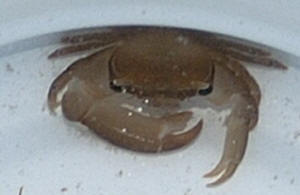
|
|
hermits eating Birdsnest 4/21/10
Hey there Crew!!!!!
<Sandra>
What would all of a sudden make hermit crabs infest and devour a
6 inch by 5 inch Pink Birdsnest?
<Hunger, awareness, perhaps a "weakened" state
sensed re the Seriatopora>
This Birdsnest has been in the same place for 2 years and was
doing awesome until 3 days ago. All of a sudden dozens of hermit
crabs started eating it. I took out all the hermits that were
eating it, any other hermits I could see at the time and did an
iodine dip on the coral and put it back in the tank. The next
morning it was infested with 15 hermit crabs again. I know
hermits are omnivorous and will sometimes eat corals.
<Oh yes>
This tank is 180 gallons, established for over 2 years. I test
for 14 different parameters and they are all within acceptable
range. The tank has probably 50 or more SPS corals in it and the
crabs aren't bothering anything but this Birdsnest. What
might the Birdsnest have acquired to all of a sudden make it a
magnet for hermits?
<Mmm, can't tell for sure, but "something"
changed re making it attractive as a food item>
No other corals or fish have been added to this tank in over 3
months.
I've done a microscopic analysis on the dip water to see if
anything came off of the coral and didn't find anything that
would point to the cause. There was very little detritus, no
algae spores, no worms, parasites or eggs that I
could detect. I've done analysis on problem corals before and
found detritus and algae to be a primary cause of what is
generally referred to as RTN with a secondary cause the bugs that
tend to populate in the detritus causing the loss of coral
tissue. I've never seen RTN without finding one or more of
the problems previously mentioned. I even did an RODI dip on a
branch and didn't find a single thing in the RODI water under
the microscope. I'm just perplexed. I've never seen herds
of hermits all of a sudden attack and kill a particular coral
like this. Any ideas on
what would cause them to do this? I'm attaching a picture of
my poor Birdsnest. I moved it to another tank without any SPS in
it until I can frag what I can of it and pray I can salvage a
branch or two.
<Good>
Any information you could give me would be appreciated so maybe I
can prevent this from happening to any of my other corals. I will
continue to remove all the hermits I find. You guys are
awesome!!!!
Thank you,
Sandra P.
<Other than my usual warning/admonition re the use of
"Hermits", I don't know what changed here. I salute
your promptness, actions in effort to save this colony. Bob
Fenner><<Mmm, might have been weakened by the GSP below
it...>>
|
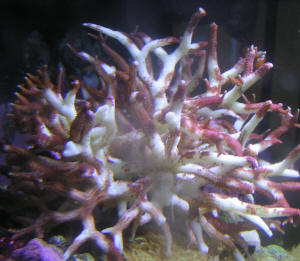 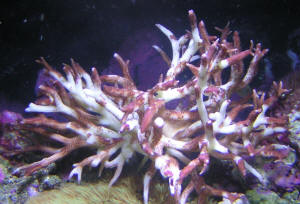 |
Coral Aggression: Galaxea 1/7/04 Brant here again,
<cheers> I really appreciate having such an informative site. I
wanted to mention in reference to my last e-mail about white band that
I also got a Galaxea at the same time. I placed it on the top of a rock
in the center of the aquarium with some distance between corals.
<grumble, grumble... would rather have heard it was placed properly
in a QT tank first for 4+ weeks. We might not be having this exchange
if so <G>> The Stylophora is only 3-4 inches away and is
somewhat 'downstream' from the Galaxea. <Yikes! The Stylo is
soon to be Galaxy coral food> I've read a lot about sweeper
tentacles <eventually 10" long from Galaxea... they are one of
the worst> and was wondering if this had anything to do with my
Stylophora problem. <very easily so> My salt level is low also,
at about 1.019. <do get this up to 1.023-1.025 for corals>
Besides the Stylophora problem, I was wondering if I could/should place
my Galaxea directly on the floor of the tank at the farthest distance
from everything else? <perhaps... they are one of the most
aggressive corals in the trade> Your help is greatly appreciated.
Sincerely, Chris Brant <best of luck, Anthony>
Pocillopora Hitch-hikers! Yep, two of them. 7/27/05
Hello Crew. Let me start off by thanking you for being here, and I
thank you for your consideration of my issue. <Welcome> I
have a 117 gallon reef tank with the following statistics:
Hardware: Dimensions: 85" X 18" X 8" <?
eight...> Pumps: 3 Eheim 1260s and 1 Mag drive 5 Lights: 3 250
Watt MH w/14K Bulbs Photo-period: 10 hours/day Chiller: 1/3 hp
Arctica Water Quality: Temp: 78 degrees F, + or - 1 degree Specific
Gravity: 1.025, top off done with dosing pump and float valve in
sump. Calcium: 420, achieved through daily Calcium Hydroxide Slurry
Shots. Corals deplete Ca by 10 ppm/day. <About right> dKH: 12
pH: 8.0 - 8.2 (I'm currently working on more frequent, twice
weekly, water changes to bring this up. I will also soon add a
refugium with macro-algae to help maintain a higher pH. <Eight
is fine> Iodide: 0.03 ppm Magnesium: 1350 ppm (I had to
supplement to get it above 1300) Strontium: 10 ppm Ammonia: 0 ppm
Nitrite: 0 ppm Nitrate: 0 ppm Phosphate: 0.075 ppm Saltwater:
Instant Ocean mixed with RO/DI Water Changes: 15 gallons every
Sunday. <All sounds, looks good> Tank Inhabitants: Fish: 1
Clown Goby; 1 Citron Goby; 1 Bi-color Blenny; 1 Firefish; and 1
Watchman Goby Invertebrates: 1 Tridacna Maxima Clam; 1 Montipora
sp. (plate form); 1 Pocillopora damicornis; 1 Seriatopora
caliendrum; two Zoanthus sp. colonies; 1 Parazoanthus gracilis
colony; 2 Xenia Fragments; 2 Ricordea sp.; 1 Lobophyllia sp.; 1
Nephthea sp; 1 Haliclona sp.; <Wow, not easily kept> 20
Nassarius Snails; 2 cleaner Shrimp; and a coral that is either a
Pectinia sp. (what the dealer ID'd it as), Symphyllia sp., or
Oulophyllia sp. I have attached a picture to help with ID.
<Please see my pics re these genera in turn, on WWM> My
system was converted to a reef tank in March. The corals have been
added at a rate of approximately one every couple of weeks, and the
fish have only been in the tank for one month. I am getting very
good growth from the Montipora, Nephthea, Blue Sponge, and Green
Star Polyps. The Lobophyllia has been in the tank for a couple of
weeks, and the Pectinia (?) a little over a month. Both get fed
every morning with pieces of krill, scallops, silversides, or mysis
shrimp. I can't say that I see growth in them, but I am hopeful
as they eat a considerable amount daily. <Do grow... hard to
tell when you see often... a pic is often very useful... The coral
that presents an issue for me at the moment is the Pocillopora.
I've had the coral for about 2 months, and it has just started
to show signs of tissue necrosis along the backside of the coral.
Also, many of the polyps deep inside of the branches are now
failing to expand. I don't know if the tissue loss is due to a
lack of food (I feed Cyclops-eeze, live phytoplankton and Selco 3
times/week), or if the hitch-hikers are stressing the coral? My two
hitch-hikers are a red colored crab and some kind of small Goby. I
have never seen the crab do damage to the coral, and to be honest,
I just saw the Goby for the first time last week. What makes this
so amazing is the fact that I stare into the tank for at least an
hour every day. How the Goby has managed to keep hidden is beyond
me. <Happens...> The Goby has a black back half, and I
believe that the front half is a dull yellow. It is hard to get a
good look at him, as he is always hiding behind the crab (and I
mean right next to it) or on the side of the coral that faces the
rear of the tank. Also, I notice that my Clown Goby is constantly
hovering in the coral's branches, and he sometimes nips at the
polyps. It is either a territorial thing with the hitch-hiker Goby,
or he wants to mate. One of my fish books mentions that Clown
Gobies will nip SPS polyps during mating, but that it does little
damage. I am also noticing that the clown Goby is now nipping at my
Bird's Nest coral. Should I be concerned about the nipping
behavior? <In this size, well set-up, maintained, fed and
stocked system, I would not be concerned> Should I try to rid
the Pocillopora of its hitch-hikers? If yes, then how do you
recommend that I do it? <I would not get rid of this stony
coral, nor worry re the crab, goby... likely the Pocillopora is
still just "settling in", but I would make sure that
other cnidarians are mal-influencing its health... make sure other
"corals" are placed far enough away, use some activated
carbon in your filter flow path...> Lastly, could you take a
look at my picture and let me know which species of coral I have? I
would greatly appreciate it. I've also attached a picture of
the Pocillopora for your review. <Might be a Symphyllia...>
Thank you once again for your kind service. You guys and gals
always seem to pull me through when I need assistance. Lou
<Glad to offer my input. Bob Fenner> |
| Re: Pocillopora Hitch-hikers! Yep, two of them. 7/28/05
Thanks for the response Bob. Of course it would happen that after I
wrote this letter to the WWM, my Pocillopora extended its polyps
fully each day since. <Heeeee!> I will take your advice and
leave the hitch-hikers alone. I will also go with Symphyllia as the
Genus for my unknown coral. As always, I appreciate the time and
consideration. Regards, Lou <Thank you... for sharing... and
writing so well. Bob Fenner> |
|
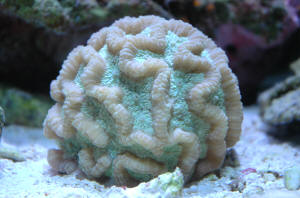 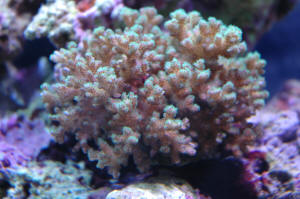
|
Crabs in my reef? Yes a Coral Crab (Trapezia
ferruginea) 3/10/07 Hello Again Bob, <Hi Brian, Mich here
tonight!> I found some crabs hanging out in a couple of my
Acropora corals last night. I have pulled them out of the reef, but
still have no clue what kind of crab they are. There are 3 photos
below if you could tell me what you think they are it would be
greatly appreciated. <This looks like a Coral Crab (Trapezia
ferruginea). They are reef safe and eat mucus off their host coral.
They usually hitchhike on stony corals and are typically hardy when
provided a host, which is usually a Pocillopora spp. or a
Stylophora spp. If you want them to live, and you should, they need
to be returned to their respective corals.> Thank you!
Brian |
|

|
|
|

